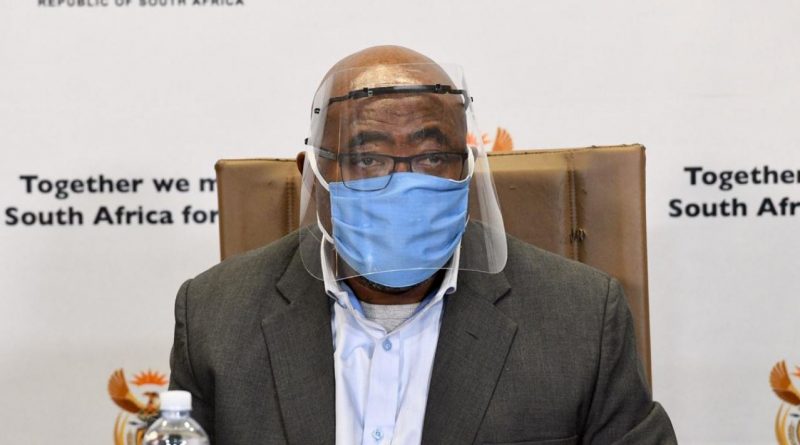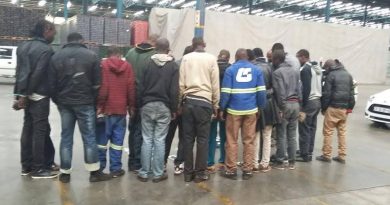Media Briefing on Stage Four Direction on Health and Safety Regulations
[TW Nxesi MP, Minister of Employment and Labour]
I. Direction for Stage 4
My main task today is to provide information on the preparations for the move to stage 4 of the lockdown and the partial return to workplaces tomorrow. This is the focus of today. However, the Deputy Minister will also provide additional information regarding the Department’s other services.
Government has said that the easing of the lockdown will be a carefully phased process based on a risk assessment and the necessary levels of preparation. Therefore, in returning to work it cannot be business as usual.
With this in mind, as the Minister of Employment and Labour, I issued a Direction – in terms of Regulation 10 (8) of the Regulations issued by the Minister of Cooperative Governance and Traditional Affairs in terms of Section 27 (2) of the Disaster Management Act, 2002 (Act No. 57 of 2002). The Direction sets out the measures that employers are required to take to prevent the transmission of COVID19 in workplaces.
The Department is working closely with the Department of Health in creating an environment to support employers in combatting the disease. It should also be flagged that the inspectorate conducts inspections at all workplaces including health care facilities in terms of the Regulations for Hazardous Biological Agents to ensure safe and hygienic conditions.
The Direction seeks to ensure that the measures taken by employers under the Occupational Health and Safety Act are consistent with the overall national strategies and policies to minimise the spread of COVID-19. The Direction reflects all that we have learnt about the virus and how to combat it over the period of the lockdown, and from international best practice.
The Direction contains the basic measures that employers must take to prevent the transmission of the coronavirus in the workplace. Businesses that are re-opening must put these measures in place before restarting work. A risk assessment or risk assessment review must be undertaken to adapt the provisions of the Direction to the specific requirements of individual workplaces. The Direction in no way reduces the existing obligations on employers in terms of the Occupational Health and Safety Act, 1993.
The Direction is based on infection transmission prevention and specific occupational hygiene practices that focus on the need for employers to implement measures to mitigate or eliminate the transmission of the virus in the workplace.
Employers must take measures to protect the health and safety of everyone in their workplace. This includes employees of contractors, self-employed persons and volunteers. The process starts with a risk assessment in the workplace and a clear plan to implement the measures contained in the Direction.
Every employer must:
• Notify workers of the contents of the Direction and how it will be implemented.
• They must inform employees that if they have COVID 19 symptoms they must not be at work and grant paid sick leave or apply for COVID19 TERS benefits.
• The employer must appoint a manager (from within the existing structure) to address the concerns of employees and workplace representatives.
• They must take measures to minimise the contact between workers and between workers and the public to prevent transmission.
• They must minimise the number of workers in the workplace at any time through shift or working arrangements to achieve social distancing.
• The employer must provide employees with information concerning COVID19 and how to prevent its transmission.
• They must report any diagnosis of COVID19 at work to the Department of Health and the Department of Employment and Labour, investigate the cause, and take appropriate measures. It is a contravention not to do so as an employer.
• They must support any contact tracing measures initiated by the Department of Health.
With regard to social distancing, workplaces must be arranged to ensure a minimum of 1½ meters between workers. If this is not practicable, physical barriers must be erected and workers must be supplied free of charge with appropriate Personal Protective Equipment (PPE).
Social distancing must be implemented in all common areas in and around the workplace to prevent crowding (including working spaces, canteens, meeting rooms etc.).
In relation to screening – Employers must screen workers for symptoms of COVID19 at the time that they report for work, namely: fever, cough, sore throat, redness of eyes or shortness of breath (or difficulty in breathing); body aches, loss of smell or loss of taste, nausea, vomiting, diarrhoea, fatigue, weakness or tiredness.
Workers should immediately inform the employer if they experience any symptoms while at work. Not doing so is a contravention of the Occupational Health and Safety Act by the worker. More importantly, the worker puts themselves – and their co-workers – at risk.
Workers with symptoms must be placed in isolation and arrangements made for their safe transport for a medical examination or for self-isolation.
Shops (and other workplaces to which the public have access) must screen all persons entering the workplace for symptoms.
Employees who recover from COVID19 may return to work after a medical evaluation and subject to ongoing monitoring, in line with instructions of the Department of Health.
In relation to sanitisers and disinfectants, employers must:
• provide sufficient quantities of hand sanitiser with at least 70% alcohol content;
• ensure that work surfaces, equipment and common areas such as toilets, door handles and shared equipment are regularly cleaned and disinfected; and
• provide adequate facilities for hand washing with soap and clean water and sufficient paper towels.
"It is inspiring to see an ever-increasing number of corporates respond to the COVID-19 challenge through the manufacturing of face masks." https://t.co/023xDU6Jgp #COVID19 #FaceMasks #Flattenthecurve pic.twitter.com/Kh2D2kFLIu
— Arrive Alive (@_ArriveAlive) May 2, 2020
Masks – Workers must wear masks at work. Employers must also require members of the public entering a workplace to wear masks.
Employers must provide each employee, free of charge, with at least two cloth masks to wear while at work or commuting. There must be suitable arrangements for washing and drying masks.
Ultimately, the employer remains responsible for the maintenance and upkeep of PPEs. Where a risk assessment indicates, workers must be provided with alternative appropriate PPE (eg N95 or N97 masks) to provide a greater level of protection.
Every workplace must be well ventilated to reduce the viral load.
In relation to Personal Protective Equipment (PPE), employers must keep up to date with recommendations from agencies such as the National Institute for Communicable Diseases and the National Institute for Occupational Health on the appropriate steps to take to prevent transmission in their workplaces and for the provision of PPE.
In relation to enforcement, Labour Inspectors are empowered to promote, monitor and enforce compliance with the Direction. An employer who does not comply with the Direction may be ordered to close their business.
In addition, as the failure to comply fully with the OHSA (Occupational Health and Safety Act) is a criminal offence, failure to take the necessary measures to prevent the transmission of COVID19 may result in criminal prosecution.
Investigation and Enforcement Services
Those are the regulations … but I also need to update you on the state of readiness, inspection and enforcement of the regulations.
• The Labour Inspectors have carried out some 2,226 inspections during the lockdown. This includes public sector premises and 86 health facilities. The rate of compliance by employers has increased from 50% to over 60% over the period of the lockdown. TheInspectors inform me that basic hygiene measures and PPEs are increasingly evident in most workplaces. Where this was not the case, on average of 9 Prohibition Orders were issued per day – leading to total or partial shutdown.
• Currently there are 170 Inspectors in the field (out of a total of 200). I need to mention that these include highly experienced and qualified inspectors, used to working with hazardous materials.
• In the 2019 budget, provision was made to employ an additional 500 Inspectors. This process is now being expedited to meet the demands of the pandemic. The Department is also looking at using accredited, registered inspection bodies to increase its reach.
• It would be impossible to inspect every one of the 1.8 million businesses. Therefore, Inspectors rely upon the support of individual workers, unions and socially responsible employers in providing vital information – which in turn allows the Inspectors to focus on hotspots and to make an example of particular offenders. In turn, this leads to greater self-regulation and compliance.
I need to make the point, that whilst we depend on the good will of responsible employers, workers also have a responsibility here: to wash or sanitise their hands, to wear the PPEs provided, to keep their workstations clean, and to follow directives in relation to health and safety. This is in everyone’s interests – so that everyone remains safe and we curb the spread of the corona virus.
We need to also stress the role of stakeholders in the workplace – the safety reps and Health and Safety Committees – which have come into their own during the present pandemic. It is vital that we get buy in from the workers in the implementation of this Direction, and we draw on the expertise that exists on the shop floor.
In addition, at national level, at Nedlac, we are discussing a framework to allow union leadership to move around to address disputes in individual workplaces. It is important that we acknowledge therole of the social partners and Nedlac in the development of the Direction.
We are also mindful that the Direction imposes a number of additional burdens upon the employers, and we will monitor this situation closely.
The COVID19 crisis has highlighted a number of gaps in our social provision. In relation to the UIF, there are important groups that are not covered – the informal sector, non-standard and freelance workers. These issues have been raised by the ILO (International labour Organisation) in relation to the Future of Work – where a growing number of persons do not fit into the traditional employer-employee relationship. This matter is firmly on the agenda. At this point, the responsibility remains within the realm of Social Development and the President’s undertaking to expand the social security safety net.
Thank you. Let me hand over to the Chief Inspector, who will address:
• The development of sector guidelines; and
• Technical aspects of the Direction.
II. Chief Inspector to present
III. DM: UPDATE ON OTHER SERVICES OF THE DEPARTMENT OF EMPLOYMENT AND LABOUR
UIF
One of our major tasks as the Department of Employment and Labour during the lockdown has been to repurpose the UIF (Unemployment Insurance Fund) to facilitate the flow of benefit payments to mitigate the effects of lay-offs. The introduction of the COVID19 TERS Benefit Scheme and the attendant massive increase in claims required that we completely redesign the architecture and supporting systems of the UIF claims process:
• Shifting from individual walk-in claims to mass distribution hubs through online applications supported by the Call Centre for enquiries;
• this required engagement with the social partners – labour and businesses – at Nedlac – and signing Memoranda of Agreements with all the employers and bargaining councils.
This meant initial delays – which are still reflected in sectors of the media, even today – but I can now report the following progress:
• Bulk disbursements of COVID19 TERS benefits of R5.3 billion through bargaining councils and employers – reaching 98 thousand employers and 1.1 million workers.
• A further R2.4 billion in COVID19 TERS benefits has been cleared for payment on Monday morning to 29 thousand employers.
• There are still a number of outstanding claims which are still to be processed – from 74 thousand employers, representing 481 thousand workers and
an amount of R1.9 billion in benefits. SARS has already validated 87% of these claims and these shall be paid next week.
• Let me emphasise: it would not have been possible to shift to a system of mass distribution hubs without the active support of business.
• Ordinary UIF claims have continued uninterrupted during the lockdown – with some R 1 billion disbursed to 65 thousand claimants.
• Remember, also, that each recipient is probably supporting a family and dependents – greatly multiplying the reach of UIF benefits.
• To give assurance that, despite these large disbursements, the Fund is able to meet its obligations, some R13.8 billion of investments has been freed up to strengthen the liquidity of the Fund.
• In addition to the systems assistance we have already received from SARS and the private sector, the company – Interfile – has offered to run the UIF SMS service at no cost. This is an important part of our service particularly to those working in isolated environments – such as domestic and farm labour.
16
• Challenges remain, particularly where employers are not assisting their employees to claim.
Compensation Fund
• In response to the declaration of a pandemic, the CF has established its Crisis Management Committee and developed a COVID-19 Response Plan to focus on COID Services (Compensation for Occupational Injuries and Diseases), Medical Benefits, Rehabilitation and Account Payable.
• Dedicated National and Provincial Response Teams have been established, comprising medical professionals and claim processors, to manage COVID-19 claims.
• Like the UIF, the Compensation Fund has opted for online applications, backed by a Call Centre, for the protection of claimants and staff, and to streamline processing and payment.
• Few claims have been registered as yet. This will change as COVID19 contracted in the workplace will be compensated as an occupational disease.
Supported Employment Enterprises
• These factories have been repurposed to supply PPEs (masks and gowns) as well as hospital linen
• They are already supplying PPEs to municipalities and provinces,
• And are in talks to supply the Department of Health – particularly to equip the field hospitals which are underway.
How can construction companies implement an effective safety protocol as lockdown regulations are eased? https://t.co/AD0DYfbxTv #Safety #COVID19 #Safety #COVID19 #WorkerSafety pic.twitter.com/xynuq2OOCY
— Construction Safety (@ConstructionSfy) May 3, 2020




